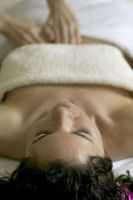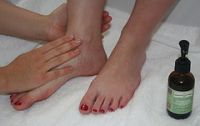Massage Remedies

4. Asthma:
Characterised by intermittent wheezing and breathlessness, asthma is one of several common symptoms of respiratory stress which is often related to emotional states such as stress and anxiety. This is where massage can play a very beneficial role, even being applied during an attack in a sitting position if the sufferer is comfortable with this, Remember to relax and warm up the area with gentle effleurage before applying the following specific movements.
A. Cup over the back area, avoiding the spine. Usually this movement is administered between attacks, when the sufferer is more comfortable, and helps to release any build-up of mucus.
B. Flick to apply friction to the spaces between the ribs (intercostals). This will stimulate the local circulation, help to promote lymph flow and relax the muscles in this area.
C. Passive movements help the expansion of the whole area, which is very useful if the sufferer is unable to exercise. Standing upright at your partner’s head, place his hands around your lower back. Support his upper arms just above the elbows, and ask him to take a deep breath. As he inhales, flex your knees and lean backward. Maintain this stretch while he exhales and then ease off, keeping hold if his arms, and straighten your knees. Repeat once.
D. For a bigger stretch, slide your hands down to your partner’s forearms with his hands gripping yours and repeat step C, stretching on his in breath and holding as he breathes out.

5. Menstruation And Menopause:
Every month many women suffer from one or many of the effects of their hormonal cycle – water retention, headaches, pelvic congestion resulting in backache, cramping and pain – caused by hormonal imbalance. By inducing relaxation, massage can reduce the symptoms of premenstrual tension, such as irritability, depression and crying spells. It can also release tightness in muscles and stimulate the blood and lymph flows, thereby helping in the elimination of toxins and excess fluid. It is however very important to work within the sufferer’s comfort level, as sometimes she may feel too tense and sensitive for anything other than very light strokes. During menopause, a different kind of hormonal imbalance causes symptoms that include sweating, hot flushes, migraines and bloating. There are other trigger points within the abdominal wall that, when treated, can bring relief – this is in contrast to abdominal massage, which can sometimes increase blood pressure and produce hot flushes. Gentle massage is ideal for reducing the musculoskeletal pain that is sometimes a characteristic of menopause.
A. Place the pads of your thumbs about 7 cm (3 in) on either side of your partner’s navel and, using your body weight, lean in toward the navel and hold for five seconds. Repeat two or three times.
B. Move your thumbs close together and, using the pads, work as in step A downward in a straight line, from just below the navel to end level with the hips, then work back up, finishing with your thumbs about 7cm (3 in) to either side of your partner’s navel. This will relax stomach tension and reduce spasms and fatigue.
C. Relax your hands by shaking them and place them lightly, close together, on the mid-abdomen, level with the navel, and effleurage and gently in an arc toward the groin and return. Make sure that you massage both sides of the abdomen equally. As you become more experienced, you may wish to use an intermittent pressure technique instead of the gliding stroke. To do this, use mostly the pads of your fingers and, instead of sliding, ‘stretch’ the tissues by alternately applying pressure and releasing as you move in an arc toward the groin. This is a very subtle movement and you should keep contact with your partner at all times. The technique works on the lymphatic flow and is especially effective in reducing water retention in the abdominal area.

6. Oedema:
Derived from the Greek word meaning ‘to swell’, oedema is simply an excess of fluid inside or between cells. It can be situated in one specific area or may spread throughout the body. There are many causes, from minor problems, such as premenstrual water retention and ‘housemaid’s knee’ caused by too much kneeling or the effects of a hot climate, to more serious problems, including heart or kidney failure and lymphoedema (swollen lymph nodes). Massage can be effective in dealing with some of the simpler problems, but treatment for more complex conditions requires professional training and, in some cases, a doctor’s approval. The techniques shown here can also be adapted for self-massage.
A. This technique is useful for dispelling ‘water on the knee’. Using the pads of your thumbs, work around the knee joint, starting at the top. Lean into the area surrounding the kneecap and move downward on each side, applying pressure slowly and to a level that is comfortable for your partner. Direct the pressure inward toward the centre and hold for five second, before moving to the next position, until you have reached the area under the joint, completing the circle. Repeat on the other leg. To finish off, move to the feet and hold for 20 seconds to ‘ground’ your partner.
B. A build-up of fluid in the upper arm can result from over-exercising, hormonal changes during menstruation, poor lymph flow or from removal of the lymph nodes during a mastectomy. Support your partner’s arm by holding the inside of their elbow and rest their forearm on yours. Using your other hand, lean into the outside of the upper arm and with your fingers and thumb squeeze over the muscle, slowly working upward from the elbow to the shoulder. Return with flat-handed effleurage down the outside of the arm. This movement is great for improving the circulation. Repeat upto five times before moving to the other arm
C. One of the most obvious area of fluid build-up is around the feet and ankles. Long periods of walking on hot summer days, aeroplane cabin pressure or tight footwear will al result in a ‘puffy’ look, which can be eased by a simple ‘drainage’ massage. Supporting the foot, make small circular movements with your fingers, always working around and not directly on the swelling. Then, with your fingers under the heel for support, press your thumb pads simultaneously on both sides of the Achilles tendon and hold the pressure for five seconds.